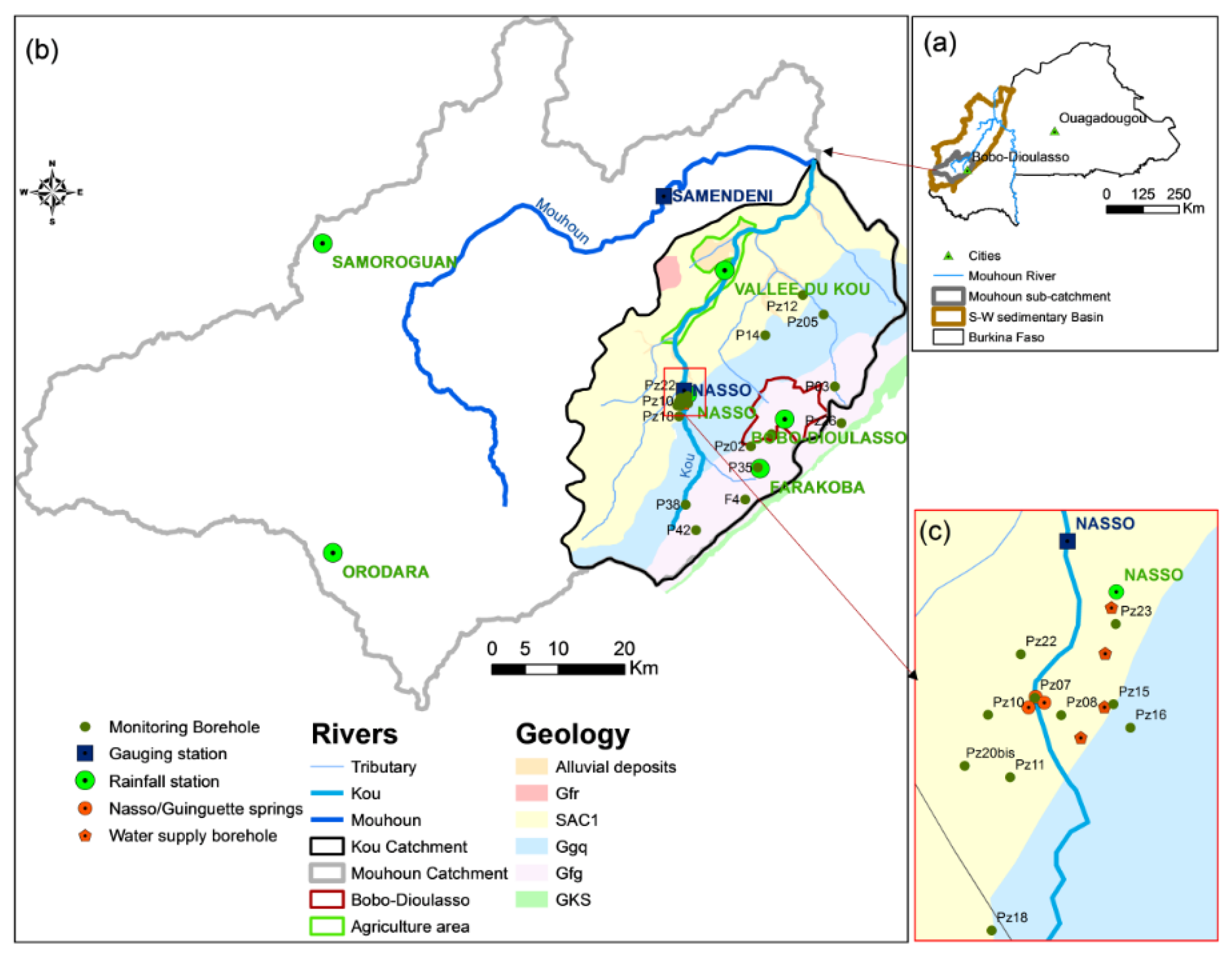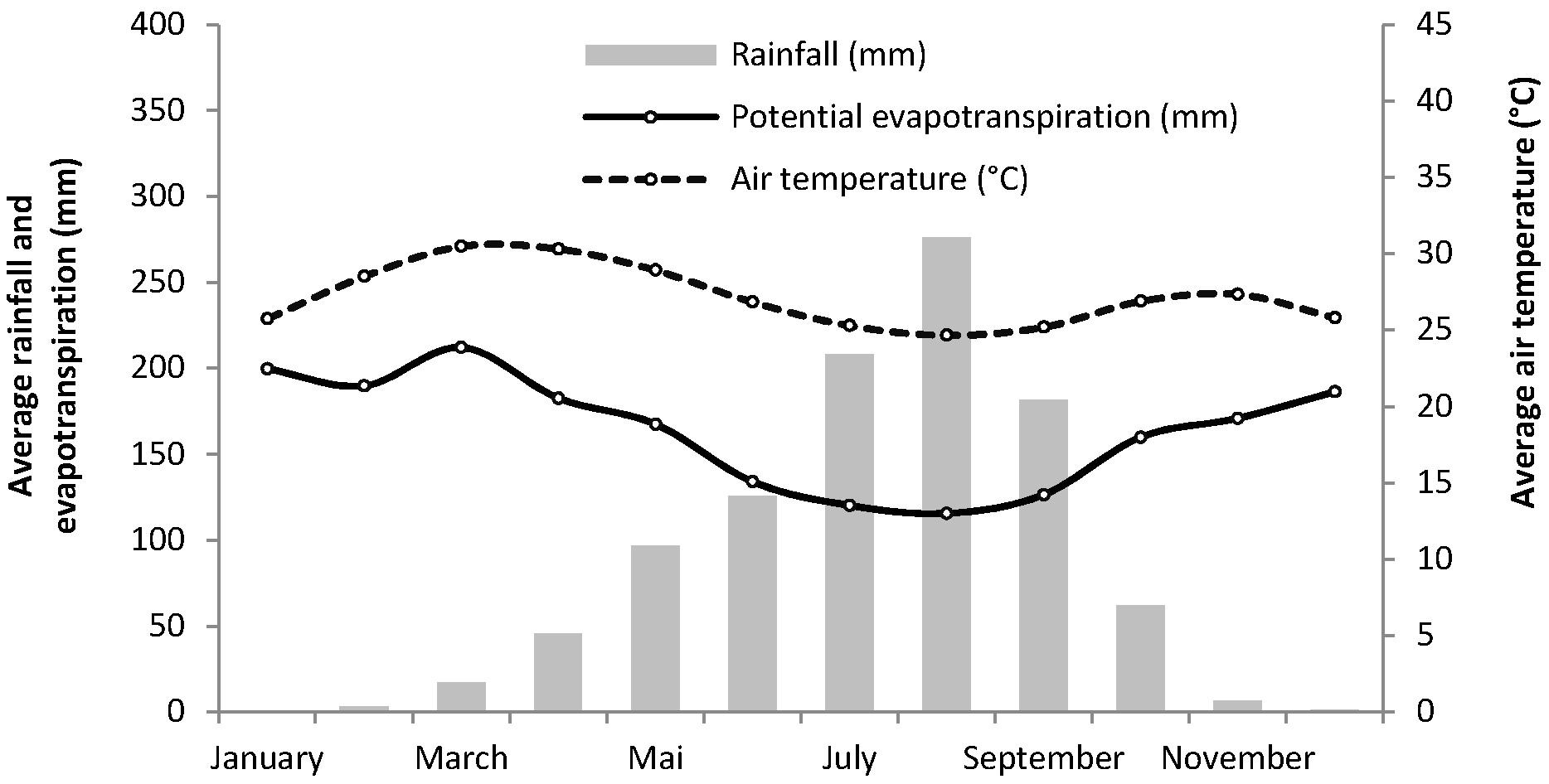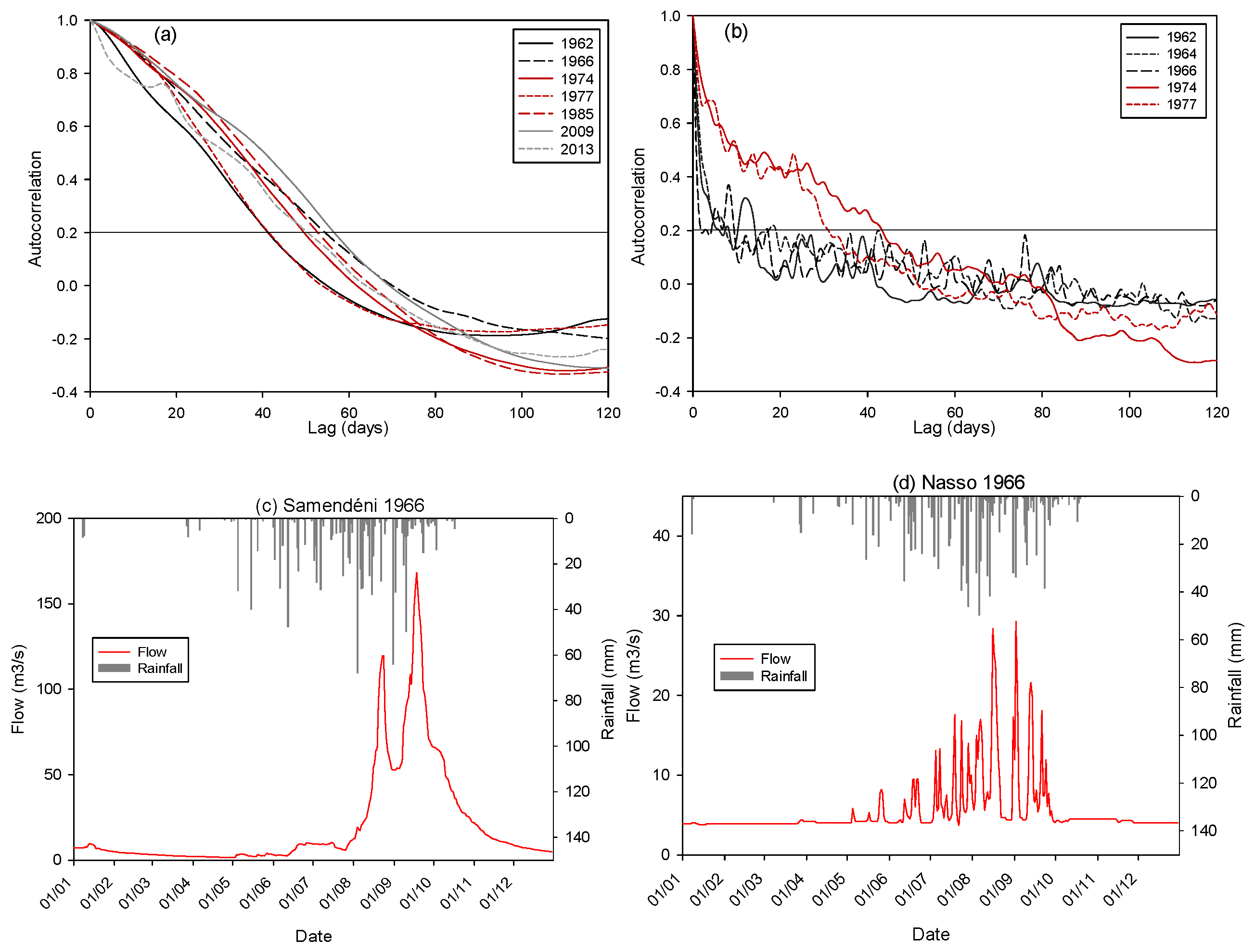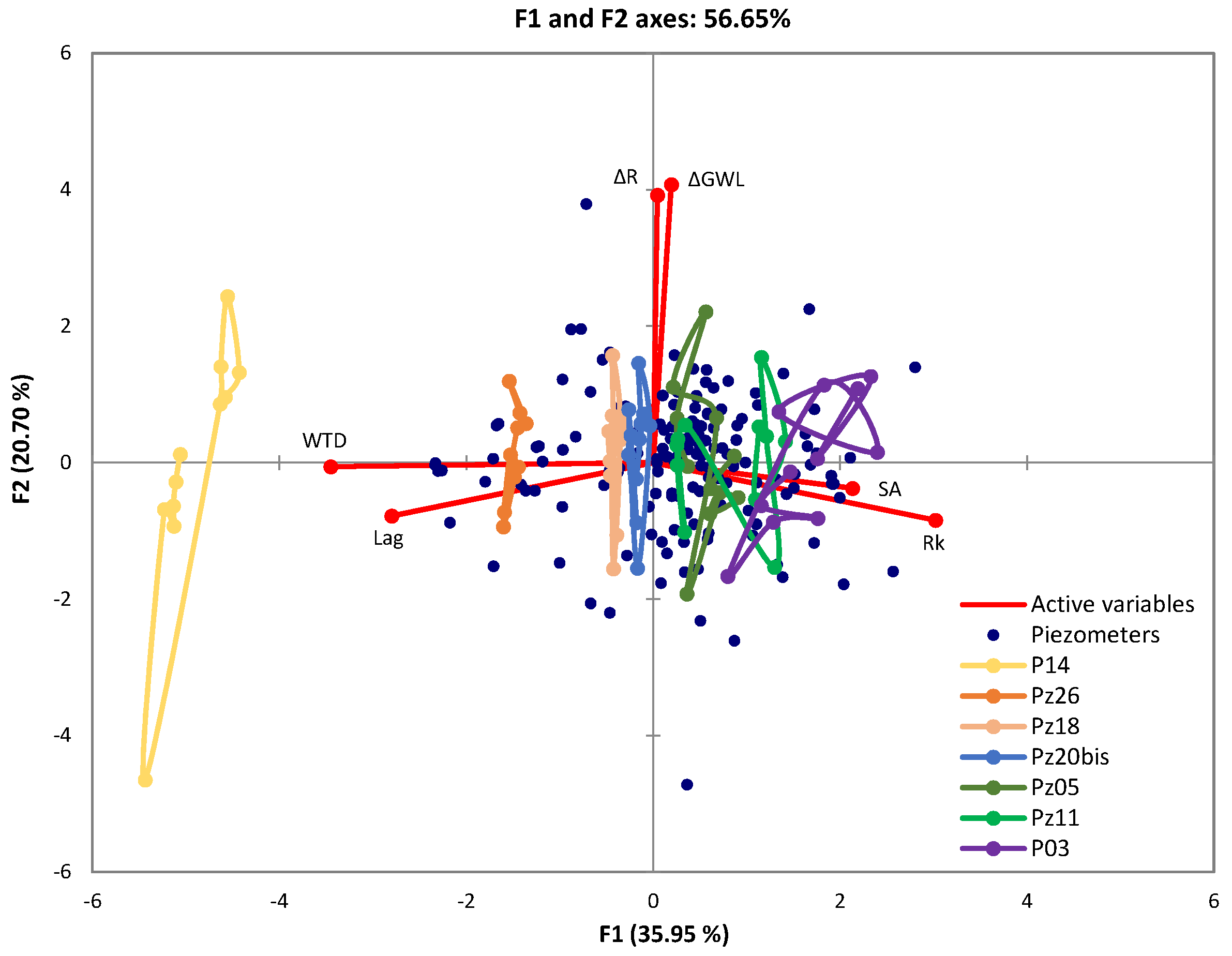3.4.1. Seasonal Variation and Rainfall-Water Level Relationship
Over the period from 1995 to 2014, the amplitude of seasonal fluctuations ranged from a few centimeters to about 2 m. The highest amplitudes were generally measured in the area close to Bobo-Dioulasso where the altitude is relatively high, and lower amplitudes were measured near the spring area. The variability of the seasonal amplitude reflects the spatial heterogeneity of the groundwater reaction to rainfall (
Figure 5a). In the recent period (2007–2014), the amplitudes generally increased compared to the previous period (1995–1999) by a few centimeters to about 70 cm.
To better characterize the response of the groundwater level, we analyzed the cross-correlation between rainfall and water level in order to estimate the time lag (months) and the magnitude of the correlation. The time lag provides information on the system transfer speed while the magnitude of the correlation indicates the degree of preservation of the rainfall impulse during the transfer [
69]. Due to the gaps in the data, this analysis was done on two three-year periods (from 1995 to 1997 and from 2012 to 2014).
Figure 6 shows the results for the 1995–1997 period. The rainfall-water level relationship did not change significantly between 1995–1997 and 2012–2014 (not shown), except Pz23, where the maximum correlation decreased from 0.7 to 0.3. Since Pz23 was very close to a pumping zone (about 100 m), this decline could be explained by the disruption of the rainfall signal by pumping.
Most of the piezometers are significantly correlated to rainfall. Typically, the groundwater response to rainfall was delayed by 1–4 months. It reached seven months (with a low correlation) on some piezometers such as P42. The strongest correlations were around 0.6 and lowest around 0.2. Only a few piezometers, including P42 and P14, do not seem to be correlated with rainfall. P42 could be located in a locally-confined area of the aquifer [
37]. P14 has the deepest water table (about 85 m), which could explain for the weak correlation between rainfall and water level and the long transfer of the rainfall signal to the groundwater (seven months).
3.4.2. Interannual Variation of Groundwater Level
Over the 1995–1999 period, all the piezometers showed a declining groundwater level with a slope ranging from −26 cm/year to −2 cm/year. Only F4 was stable and even showed a slight upward trend of 1 cm/year. After the gap between 2000 and 2006, there is a reduction of the groundwater level slope on all the piezometers. The piezometers were clustered in three groups (G1, G2, and G3) according to their behavior.
Figure 4 shows sample piezometers from each group. The water level of the piezometers situated upstream (G1) continued to decline but with a slightly lower slope (
Figure 4 and
Figure 5b). For piezometers situated downstream of the catchment (G2), the water level rose with a clear slope (5–28 cm/year). Some piezometers (P42, F4, P35, Pz23) had a singular behavior (G3). For instance, F4, which had a stable water level until 1999, then showed a downward trend with a significant slope (−16 cm/year).
The interannual trend observed on the groundwater level seems to be related to interannual rainfall variability. Over the past 25 years’ rainfall through the five-year and seven-year moving average, displayed a downward trend until 2005, where it began to move upward (
Figure 7). This trend reflects observed changes in groundwater levels. However, the exact date of the shift in groundwater levels is not clear because of the data gaps between 2000 and 2006. The similarity between inter-annual groundwater variation and the moving average of rainfall over several years reflects, in some way, a slow and long-term response of the groundwater. The slow response of underground system has been reported by several authors who argue that the rainfall signal is filtered and lagged through the soil and undergound system [
5,
70]. The aquifer reacts as a low-pass filter that smoothed out the high frequency fluctuations of the rainfall signal [
71]. About the slow response of the system, it is also shown that the underground system when subject to a disturbance (changes in boundary conditions) takes some time (few seconds to millions of years), depending on its size and its hydrodynamic characteristics, to recover its equilibrium [
72]. This response time can be estimated from the equation of Domenico
et al. [
73] which applies to a homogeneous, isotropic, and confined aquifer with purely horizontal flow:
where τ is the response time [T],
L is the length of the aquifer [L],
Ss is the specific storage [L
−1],
Kh is the horizontal hydraulic conductivity [LT
−1],
S is the storage coefficient [-], and
T is the transmissivity [L
2T
−1].
A transmissivity value of 4 × 10
−4 m
2/s, a storage coefficient of 10
–4, and a length of 30 km (average size of the catchment) gave a response time on the order of seven years. This is in agreement with the findings from Stoelzle
et al. [
68] who showed that porous systems such as sandstone have a long-term sensitivity to changes in rainfall and a stronger response to multiyear recharge variability. This slow response of the system was described earlier in
Section 3.2 and
Section 3.3.
In addition to creating a long term response to climate variability, differences in local hydrodynamic parameters may induce different responses of the groundwater level in space [
70,
74]. A strong heterogeneity of hydrodynamic parameters due to a difference in the nature of the rock or in the fault lines within the catchment can justify the difference in behavior between upstream and downstream areas. Indeed, a downstream area less transmissive and/or more capacitive than the upstream area can induce this difference.
Other factors such as groundwater withdrawal, land use, vegetation, topography [
5,
7] may also contributed to a spatial heterogeneity in the response of the groundwater. Given that upstream pumping are not substantially greater (19,800 m
3/d out of 40,700 m
3/d as a total at the catchment scale) than downstream ones, the assumption of high pumping rates is not a strong argument to justify the difference in behavior between upstream and downstream areas. In connection with topography and land use change, the assumption of higher recharge rates in the downstream area through the surface water, as observed in Southwestern Niger [
24] was also put forth but is debatable given that some piezometers are located in a high topography area (P31, Pz26).
The geological and hydrogeological characteristics of the catchment and their spatial variability seem to be the underlying factors of the interannual variation of groundwater level. However, statistical analyses alone cannot be relied on to confirm this hypothesis. Groundwater modeling is required to test it.
3.4.3. Factors Explaining the Spatial and Temporal Variation of the Water Table
The analysis of the piezometric data revealed that the hydrodynamic response of the catchment’s piezometers varies in space (21 piezometers) and time (11 years, 1995–1999, 2007–2009, 2012–2014). We tested the correlations between various environmental factors to explain these differences.
The variables that potentially explain the behavior differences in the 21 piezometers are: the water table depth, the saturated thickness of the aquifer, the altitude of the piezometer reflecting its geomorphological position (plateau, valley), the lithology of the aquifer and the spatiotemporal rainfall variation. The rainfall variable was taken into account using three different variables (annual rainfall, annual effective rainfall, and interannual average rainfall over a number of years).
The groundwater response was characterized by several variables, including:
- •
The interannual variation of groundwater level determined by the difference of the annual average groundwater levels of two consecutive years.
- •
The magnitude of seasonal fluctuations determined by the difference between the highest groundwater level and the lowest groundwater level at the annual scale.
- •
The response time estimated by the rainfall-groundwater level correlation.
- •
The rainfall-groundwater level maximum correlation (Rk) estimated by cross-correlations.
A spatial study was conducted using a PCA based on 21 individuals (the 21 piezometers) and 10 variables or parameters: the four characteristics of the groundwater response above-mentioned, the interannual average rainfall variation and the interannual average effective rainfall variation over the 11 years, the altitude of the piezometer, the lithology of the aquifer, the water table depth, and the saturated thickness of the aquifer. The statistical analyses showed that the geomorphology, the lithology of the aquifer and its saturated thickness are not discriminating parameters of groundwater behavior. The lithology of the aquifer, as described herein, does not reflect well the spatial variability of the transmissivity and the storage coefficient [
38]. Specific values of hydrodynamic parameters at each point could have been an explanatory factor of heterogeneous responses as demontred by [
70]. Furthermore, the interannual average rainfall variation and the interannual average effective rainfall variation are also nondiscriminating parameters of the groundwater behavior. As described in
Section 3.4.2, the response of the groundwater level to the rainfall interannual variability is complex. Rainfall signal is delayed and smoothed through the system so it cannot be correlate directly to groundwater level variation. Thus, these five items were discarded in later analyses.
A PCA was performed on 231 individuals (21 piezometers × 11 years) and six variables describing the groundwater behavior and the rainfall forcing (
Table 6): groundwater level interannual variations (Δ
GWL) and seasonal amplitude (
SA) defined for each year, the response time (
Lag) and rainfall-groundwater level maximum correlation (
Rk) defined for the two periods (1995–1999, 2007–2014), the annual average water table depth (
WTD), and the rainfall variation defined by the difference between two consecutive seven-year moving averages (Δ
R) calculated for each year. Generally, all these variables displayed different values from one piezometer to another. Only the rainfall value was area-specific, as defined using the Thiessen polygon method.
From the results of the
PCA, we retained the first two factorial axes (56% of the variance explained,
Table 7) to explain the groundwater spatiotemporal behavior (
Figure 8). The first factorial axis (
F1) was positively represented by seasonal amplitude and maximal correlation. These two variables contrasted with water table depth and lag. The thicker the unsaturated zone was, the longer the groundwater response time to rainfall was and the less groundwater level was correlated to rainfall. In this case, the groundwater level reacted with a low amplitude. The second axis (
F2) was mainly represented by the interannual variation of rainfall and groundwater level. These results were obtained with an average rainfall over several years (seven years), suggesting that the groundwater level interannual variation is the result of the slow response of the groundwater to interannual rainfall fluctuations.
According to these results, rainfall variation explains the temporal variation of the groundwater level on the Y-axis while the spatial variation of the system response is shown on the X-axis. Piezometers are represented globally in two ways. For some of them (e.g., Pz26 or Pz18) with a shallow water table, the individuals are aligned on the Y-axis, showing low sensitivity as regards the spatial response of the underground system (
Figure 8). For other piezometers (e.g., P03 or P14), the individuals are dispersed on both the
X-axis and the Y-axis, which shows a sensitivity to change in the rainfall and to environmental characteristics (
Figure 8). All piezometers were sensitive to changes in rainfall.
The results from the
PCA concur with the preceding analyses in
Section 3.4.1 and
Section 3.4.2. Indeed, the groundwater seasonal variations is strongly linked to the water table depth [
69] and explains, to an extent, the spatial variability of the groundwater behavior. Slimani
et al. [
6] also support that the thicker the surficial formations is, the more the high-frequency variation (inferior to the annual variability) is mitigated in favor of low frequency variation. Considering P14, which has the deepest water level, whilst the groundwater interannual variation is well marked, it has a very low sensitivity to seasonal variations (
Figure 4 and
Figure 8). Thus, the hydrodynamic characteristics of the aquifers contributed to delay and smooth rainfall signals [
70] and, therefore, create a long-term sensitivity to rainfall variability [
68].
Factors that govern the groundwater behavior could be further explored if data are available on land use, groundwater abstraction, soils, transmissity, and storage coefficient. At this stage, it can be considered that the results provide some avenues to separate the causes of spatial variability and temporal variability on the groundwater level fluctuation.














